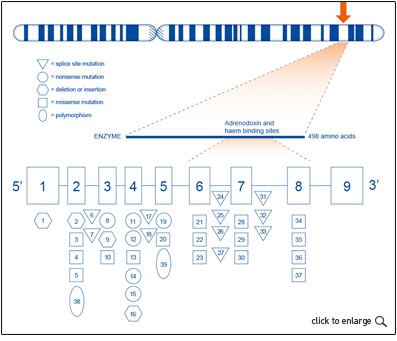Signs and symptoms of CTX
Learn more about the manifestations of CTX caused by CYP27A1 mutations.
For US HCPs Only
The estimated prevalence of CTX in the general population ranges from 1 in 44,000 to in 3,400,000.3,4
CTX is widely recognized to be a rare genetic disorder in the general population; however, it occurs at a higher frequency in certain genetically isolated populations. These include Sephardic Jews (especially those of North African origin) and the Druze community.5-8 In people of Moroccan Jewish ancestry, the frequency of genetic variants associated with CTX has been estimated at 1/108, with a disease frequency of approximately 6/70,000.6
CTX is caused by mutations in the CYP27A1 gene on chromosome 2q, which codes for the mitochondrial enzyme 27-hydroxylase.2,10,11 Forty-nine separate mutations in the CYP27A1 gene have been identified in families affected by CTX.2 No genotype-phenotype correlation has been observed in CTX; manifestations vary even in patients with the same mutations.7,9,12

The information contained in this website is intended for healthcare providers and not for the general public.
References: 1. Lorincz MT, et al. Arch Neurol. 2005;62:1459-1463. 2. Gallus GN, et al. Neurol Sci. 2006;27:143-149. 3. Freedman SF, et al. J APPOS. 2023;27(4):208-211. 4. Pramparo T, et al. Orphanet J Rare Dis. 2023;18(1):13. 5. Reshef A, et al. J Lipid Res. 1994;35:478-483. 6. Berginer VM, Abeliovich D. Am J Med Gen. 1981;10:151-157. 7. Leitersdorf E. Am J Hum Gen. 1994;55:907-915. 8. Berginer VM, et al. Pediatrics. 2009;123:143-147. 9. Verrips A, et al. Brain. 2000;123:908-919. 10. Rafiq M, et al. Pract Neurol. 2011;11:296-300. 11. Chiang JYL. Front Biosci. 1998;3:176-193. 12. Gupta RP, et al. Metabolism. 2007;56:1248-1255. 13. Genetics Home Reference. CYP27A1. Accessed November 3, 2023. http://ghr.nlm.nih.gov/gene/CYP27A1.
©2024 Mirum Pharmaceuticals, Inc. All rights reserved. March 2024 US-DS-2300059
